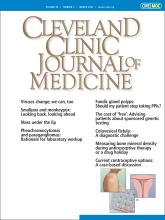Article Figures & Data
Tables
Feature Sporadic fundic gland polyps Syndromic (FAP-associated) fundic gland polyps Number < 20 ≥ 20, often hundreds8 Location Body of the stomach Mostly in the body of the stomach, but can also be seen in the antrum Presence of dysplasia Rare In 25%–40%5 Age Older; average age 40 Under age 40 Sex More common in females than males Incidence similar in both sexes6 Other EGD findings None known Concurrent duodenal adenomas can be seen7 EGD = esophagogastroduodenoscopy; FAP = familial adenomatous polyposis
Based on information in references 5–8.
Definitive (> 8 weeks) Conditional Barrett esophagus (unrelated to GERD symptoms or esophagitis) PPI-responsive, endoscopy-negative reflux disease with recurrence on PPI cessation Erosive esophagitis Los Angeles classification grade C/D PPI-responsive functional dyspepsia with recurrence on PPI cessation Esophageal stricture due to GERD PPI-responsive upper-airway symptoms with recurrence on PPI cessation NSAID/antiplatelet users with increased risk of ulcers and bleeding Refractory steatorrhea in chronic pancreatic insufficiency with enzyme replacement Eosinophilic esophagitis Secondary prevention of peptic ulcers without concomitant antiplatelet drugs Pathological hypersecretory conditions (Zollinger-Ellison syndrome) Prevention of progression of idiopathic pulmonary fibrosis GERD = gastroesophageal reflux disease; NSAID = nonsteroidal anti-inflammatory drug; PPI = proton pump inhibitors
Based on information in references 21 and 22.









